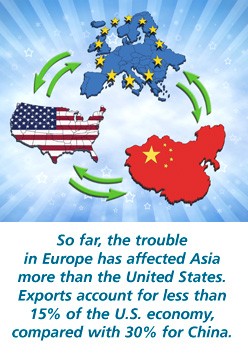Watching for Weakness in the Global Economy
 In April, the International Monetary Fund (IMF) forecasted global economic growth of 3.5% for 2012, noting that the U.S. economy had gradually gained momentum, whereas China and other emerging economies appeared to be headed for gradual slowdowns. However, the IMF also warned that if the debt crisis in Europe deteriorated into a worldwide financial crisis, the fallout could produce a 2% drop-off in global growth over two years.1
In April, the International Monetary Fund (IMF) forecasted global economic growth of 3.5% for 2012, noting that the U.S. economy had gradually gained momentum, whereas China and other emerging economies appeared to be headed for gradual slowdowns. However, the IMF also warned that if the debt crisis in Europe deteriorated into a worldwide financial crisis, the fallout could produce a 2% drop-off in global growth over two years.1
More recent economic data released in May suggests that growth slowed more than expected in a number of the world’s major economies, primarily because problems in Europe have recently re-emerged.
There are significant differences in the economic challenges facing government leaders in Europe, Asia, and the United States, yet expanded world trade and globalization in general have made the fates of many nations more interdependent.
All Eyes on Europe
In mid-May, Greek political parties were unable to form a coalition government, and a caretaker government was named until new elections take place in mid-June. The outcome is likely to determine whether Greece will abide by the deal reached to restructure its debt under conditions set by the European Union (EU), the International Monetary Fund, and the European Central Bank. Voter anger over austerity measures and resulting political instability have reignited uncertainty about whether Greece will stay in the eurozone.2
Eurozone unemployment has risen to record highs (10.9%), and strict austerity programs in a number of European nations have held back growth more than expected. Europe barely avoided a recession during the first quarter of 2012, but 11 individual nations in the EU are judged to be in a recession.3
China
Economic data measuring trade, investment, spending, and output for April was surprisingly weak, prompting government action to help promote lending and speed up economic growth. The People’s Bank of China lowered the share of deposits that banks must hold in reserve (the required reserve ratio) by 0.5%.4
Until recently, Chinese leaders seem to have been more concerned about fighting inflation. However, China’s economic growth slowed from 8.9% to 8.1% in the first quarter — the slowest pace in nearly three years — when an uptick was expected.5–6 Reduced European demand for Chinese goods has been cited as a reason for the slowdown; the eurozone is the largest market for Chinese exports.7
When balancing growth and inflation, China’s authoritarian government may be able to act more decisively than democratic societies. Elected leaders often negotiate or justify policy moves and contend with public backlash. But Chinese leaders grapple with many of the same risks as other nations in the global marketplace.
India
The inflation rate in India (9% for most of 2011) is still the highest among the emerging-market nations known as BRICS (Brazil, Russia, India, China, and South Africa). Inflation has been cooling, but prices rose faster than predicted (7.23%) in April.8
Efforts to lower inflation, along with fewer exports to Europe, caused economic expansion to sag to a three-year low of 6.1% in the December quarter. In response, India’s central bank cut interest rates for the first time since 2009.9
Fiscal deficits and political gridlock have also put India’s investment-grade status at risk. Standard & Poor’s recently lowered the country’s credit outlook from “stable” to “negative.”10
Will U.S. Fortunes Follow?
So far, the trouble in Europe has affected Asia more than the United States. Exports account for less than 15% of the U.S. economy, compared with 30% for China.11
Still, if conditions in Europe worsen, the situation could continue to affect trade and growth around the world. Therefore, U.S. consumer and investor confidence is likely to depend on how the situation in Europe ultimately unfolds.
Investing internationally carries additional risks such as differences in financial reporting, currency exchange risk, as well as economic and political risk unique to a specific country. This may result in greater investment price volatility. All investments are subject to market fluctuation, risk, and loss of principal. When sold, investments may be worth more or less than their original cost. Investments seeking to achieve higher yields also involve a higher degree of risk.
1) The Fiscal Times, April 17, 2012
2) The Wall Street Journal, May 17, 2012
3, 5, 7) CNNMoney, May 15, 2012
4, 6, 11) The Wall Street Journal, May 14, 2012
8–9) The New York Times, May 14, 2012
10) Bloomberg.com, May 14, 2012
The information in this article is not intended as tax or legal advice, and it may not be relied on for the purpose of avoiding any federal tax penalties. You are encouraged to seek tax or legal advice from an independent professional advisor. The content is derived from sources believed to be accurate. Neither the information presented nor any opinion expressed constitutes a solicitation for the purchase or sale of any security. This material was written and prepared by Emerald. Copyright © 2012 Emerald Connect, Inc.

